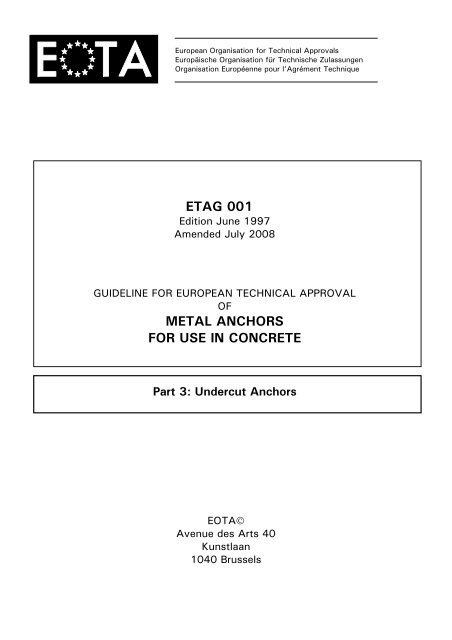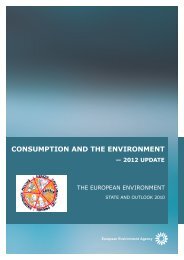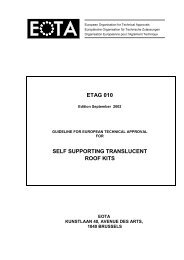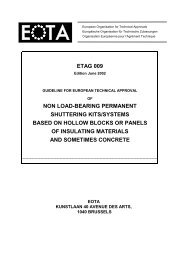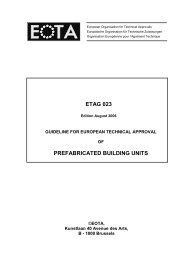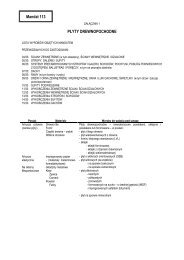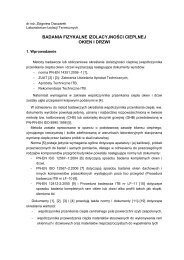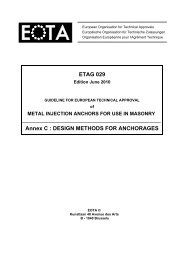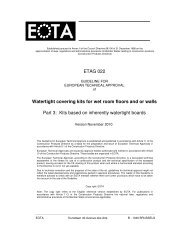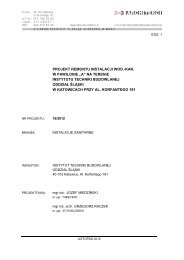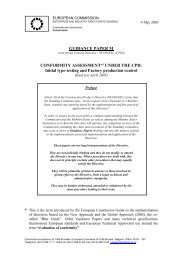ETAG 001 Part 3 Progress file_wersja zatw
ETAG 001 Part 3 Progress file_wersja zatw
ETAG 001 Part 3 Progress file_wersja zatw
You also want an ePaper? Increase the reach of your titles
YUMPU automatically turns print PDFs into web optimized ePapers that Google loves.
European Organisation for Technical ApprovalsEuropäische Organisation für Technische ZulassungenOrganisation Européenne pour l’Agrément Technique<strong>ETAG</strong> <strong>001</strong>Edition June 1997Amended July 2008GUIDELINE FOR EUROPEAN TECHNICAL APPROVALOFMETAL ANCHORSFOR USE IN CONCRETE<strong>Part</strong> 3: Undercut AnchorsEOTA©Avenue des Arts 40Kunstlaan1040 Brussels
<strong>ETAG</strong> <strong>001</strong> <strong>Part</strong> 3, Page 2TABLE OF CONTENTSINTRODUCTORY NOTES ........................................................................................................................................ 22 SCOPE.............................................................................................................................................................. 22.1.1 Types and operating principles ................................................................................................... 22.1.1.1 Displacement-controlled installations................................................................................ 32.1.1.2 Torque-controlled installations ........................................................................................... 62.1.3 Dimensions .................................................................................................................................... 64 REQUIREMENTS FOR WORKS...................................................................................................................... 75 METHODS OF VERIFICATION........................................................................................................................ 75.1 Methods related to 4.1 (mechanical resistance and stability) ........................................................... 75.1.2 Tests for suitability........................................................................................................................ 75.1.2.0 Setting tests .......................................................................................................................... 75.1.2.1 Tests for installation safety acc. to Table 5.1 line 1 .......................................................... 95.1.2.2 Tests according to Table 5.1, lines 2 to 6......................................................................... 105.1.2.3 Functioning under repeated loads.................................................................................... 105.1.2.4 Torque tests ........................................................................................................................ 115.1.2.5 Sensitivity to brittle fracture .............................................................................................. 116 ASSESSING AND JUDGING THE FITNESS OF ANCHORS FOR AN INTENDED USE............................. 146.1 Assessing and judging related to 4.1 (mechanical resistance and stability)................................. 146.1.1.1 Criteria valid for all tests .................................................................................................... 146.1.2.2.7 Minimum spacing s min and minimum edge distance c min ................................................ 146.7 Identification of anchors...................................................................................................................... 14INTRODUCTORY NOTESThe requirements, criteria and test information additional to <strong>ETAG</strong> <strong>001</strong> <strong>Part</strong> 1 for undercut anchors are given inthis <strong>Part</strong>. The same numbering of paragraphs as in <strong>Part</strong> 1 is used. If a paragraph is not mentioned, then the text in<strong>Part</strong> 1 applies without modification.References:[1] EN ISO 6507-1; 2005: Metallic Materials – Vickers hardness test - <strong>Part</strong> 1: Test method[2] EN ISO 6508-1; 2005: Metallic Materials – Rockwell hardness test - <strong>Part</strong> 1: Test method2 SCOPE2.1 Anchors2.1.1 Types and operating principlesUndercut anchors are characterised by mechanical interlock provided by undercut in the concrete.The undercutting can be achieved by:− Hammering or turning (or combination of both) the anchor sleeve into a drilled undercut hole.− Driving the anchor sleeve on to the tapered bolt in a cylindrical hole either by hammering or turning (orcombination of both). The concrete is mostly cut away rather than compressed.− Screwing the anchor into a pre-drilled cylindrical drill hole. The special thread of the anchor cuts an internalthread into the concrete member while setting.The expansion into the undercut position shall be easily verifiable after anchor installation, e.g. by a mark on theanchor.
<strong>ETAG</strong> <strong>001</strong> <strong>Part</strong> 3, Page 3The following types of installations can be distinguished2.1.1.1 Displacement-controlled installationsWith anchors according to Fig. 2.1, 2.2, 2.4 and 2.5, the cylindrical holes should be drilled with a stop-drill toensure their correct depth.a) Undercut drilled before anchor installationThe different types of anchor installation are described in Figures 2.1 to 2.3:Figure 2.1Anchor installation by hammering the anchor sleeve onto the coneFigure 2.2Anchor installation by hammering the expansion element (cone) into the anchor sleeve
<strong>ETAG</strong> <strong>001</strong> <strong>Part</strong> 3, Page 4Figure 2.3Anchor installation by pulling the cone with a defined expansion displacement into the anchorsleeve by turning the nut. This can be achieved by a special installation tool.b) Undercut made during the setting of the anchor (self-cutting undercut anchors), includingconcrete screwsThe different types of anchor installation are described in Figures 2.4 to 2.6.A combination of Figure 2.4 and 2.5 is also possible.Figure 2.4Anchor installation by hammering the sleeve over the cone; e.g. by using a drilling machine
<strong>ETAG</strong> <strong>001</strong> <strong>Part</strong> 3, Page 5Figure 2.5Anchor installation by rotating the anchor sleeve, e.g. by means of the drilling machine; therebyundercutting the concrete and forcing the sleeve over the cone. To facilitate the undercutting,the end of the anchor sleeve can be specially designed (e.g. with cutting pins)In-place installationh ef = 0.85(h nom - 0.5h t - h s) ≤ 8 d 0TorqueT insththefhnomd 0hsPre-positioned installationbitconnectionthread forConcrete screwsFigure 2.6Installation by driving the concrete screw with a self cutting special thread with wrench orimpact screw driver in predrilled cylindrical hole.Concrete screwsThe anchor is screwed into a pre-drilled cylindrical hole. The special thread of the anchor cuts an internal threadinto the concrete member while setting. The installation may be done by a non-calibrated torque wrench, acalibrated torque spanner or an electrical or pneumatic impact screw driver. The anchorage is characterised bymechanical interlock in the concrete thread.The anchor may be used only once.The effective anchorage depth of concrete screws shall be determined acc. to Figure 2.6.Concrete screws with a thread over the entire anchorage depth are covered only.
<strong>ETAG</strong> <strong>001</strong> <strong>Part</strong> 3, Page 62.1.1.2 Torque-controlled installationsThe different types of anchor installation are described in Figures 2.7 and 2.8.Figure 2.7Anchor installation by forcing the expansion elements against the undercut by applying adefined torque momentFigure 2.8Anchor installation by pulling the cone into the anchor sleeve by applying a defined torquemoment2.1.3 DimensionsIn general <strong>Part</strong> 1, 2.1.3 applies with the following explanations for concrete screws acc. to Figure 2.6:- Diameter: the shaft of the concrete screw applies- The requirement for the minimum anchorage depth is fulfilled with the condition (h nom – h s ) ≥ 40 mm acc. toFigure 2.6
<strong>ETAG</strong> <strong>001</strong> <strong>Part</strong> 3, Page 74 REQUIREMENTS FOR WORKS4.1.2.6 Types of installationWhen installing undercut anchors by displacement control (see Figure 2.1 to 2.5), the amount of energy input forfull expansion should be relatively small (e.g. up to 4 hammer blows or 15 seconds installation time with a drillingtool).To ensure the clamping of the fixture against the concrete surface, correctly installed undercut anchors shall bepositioned such, that after anchor installation including tightening the anchor with the maximum allowable torquemoment, the sleeve does not bear against the fixture (pre-positioned installation) or the washer (in-placeinstallation) respectively.5 METHODS OF VERIFICATION5.1 Methods related to 4.1 (mechanical resistance and stability)In addition to the measurements required in <strong>Part</strong> 1, the following measurements should be performed and theresults recorded:Displacement-controlled installation (see Figures 2.1 to 2.5)− Length of the stop drill (if used)− Dimensions of the drill bit for undercutting the concrete (if used)− Position of the sleeve in relation to the concrete surface (pre-positioned installation) or the fixture (in-placeinstallation) respectively, after anchor expansion and after the torque moment is applied, if applicable.− Spreading displacement (relative displacement between sleeve and cone during expansion)Torque-controlled installation (see Figures 2.7 and 2.8)− Dimension of the drill bit for undercutting the concrete− Position of sleeve in relation to the concrete surface (pre-positioned installation) or the fixture (in-placeinstallation), respectively, after the torque moment is applied.− Number of revolutions of the nut or bolt at the applied torque moment.5.1.2 Tests for suitabilityThe types of tests, test conditions and the number of required tests as well as the criteria applied to the results aregiven in Table 5.1. This table is valid for anchors for use in cracked and non-cracked concrete. The tests shall beperformed with single anchors without edge and spacing effects under tension loading.5.1.2.0 Setting testsSetting tests acc. to Table 5.1 line 0 (a), (b) and (c) are only required for concrete screws according to Figure 2.6.The tests shall be performed with the most adverse head form of the product. If the most adverse head form is notobvious all head forms shall be tested.(a) Tests in low strength concreteThe following test conditions shall be kept:• non- cracked concrete C20/25;• Cutting diameter of drill bits d cut = d cut,max ;• 10 tests with each anchor size;• The anchor shall be set with a calibrated torque wrench up to the designated depth. Intests with the pre-positioned anchor version with connecting thread the anchor shall besupported on the bottom of the drill hole (h 1 ≈ h nom ). Afterwards the torque shall beincreased up to failure; the ultimate torque moments of the test series (T U ) and the 5 %fractile of the ultimate torque shall be determined.The following conditions shall be met:(1) It must be possible to properly set the anchor. The maximum torque moment to set theanchor with the designated setting depth and the torque moment to tighten the fixturemust be ≤ T inst .(2) Tests with steel failure: T U,5% ≥ γ S,T x γ 3 x T inst x f u,test / f u,nom (A)(3) Tests with concrete failure T U,5% ≥ γ C,T x γ 3 x T inst x (f c,test / f c,nom ) 0.5 (B)where
<strong>ETAG</strong> <strong>001</strong> <strong>Part</strong> 3, Page 8(b)T U,5γ S,Tγ C,T5% fractile of the ultimate torque moments T U= 1.5 partial safety factor for steel failure= 2.1 partial safety factor for concrete failureγ 3 = 1.0 for coefficient of variation v ≤ 15%,= 1.0 +[v(%) – 15] x 0.03 for coefficient of variation of ultimate torque moments15 % < v ≤ 30% according to <strong>ETAG</strong> <strong>001</strong>-4, 6.1.1.1 (c), v coefficient of variation ofultimate torque moments.T inst Installation torque recommended by the manufacturer (if no installation torque isspecified by the manufacturer, T inst should be determined in high strength concrete. T instis the maximum torque required to completely set the anchor in tests according to (b).f u,test Tension strength of the anchor determined in identification testsf u,nom Nominal tension strength of the anchor specified by the manufacturerf c,test Concrete strength in the test seriesf c,nom = 20 N/mm² (measured on cylinders), nominal concrete strength required for the test.If in all tests steel failure occurs, equation (B) may be omitted. If equation (B) is fulfilled, equation (A) maybe omitted.The anchor may only be set without control of the installation torque (e.g. with a wrench or ratchet withoutmeasured the applied torque) if in all tests steel failure occurs.Tests in high strength concreteThe following test conditions shall be kept:• non-cracked concrete C50/60;• Cutting diameter of drill bit d cut = d cut,min ;• 10 tests with each anchor size;• The anchors are set with a calibrated torque wrench up to the designated setting depth. Intests with the pre-positioned anchor version with connecting thread the anchor shall besupported on the bottom of the drill hole (h 1 ≈ h nom ). The maximum value of the requiredtorque moment shall be measured. Afterwards, the torque shall be increased up to failure;the ultimate torque (T U ) and the 5 % fractile of the ultimate torque moments of the testseries shall be determined.The following test criteria shall be met:(1) It must be possible to properly set the anchor. The maximum torque moment to set theanchor with the designated setting depth and the torque moment to tighten the fixturemust be ≤ T inst .(2) Tests with steel failure: T U,5% ≥ γ S,T x γ 3 x T inst x f u,test / f u,nom (A)(3) Tests with concrete failure T U,5% ≥ γ C,T x γ 3 x T inst x (f c,test / f c,nom ) 0.5 (B)whereT U,5 5% fractile of the ultimate torque moments T Uγ S,Tγ C,T= 1.5 partial safety factor for steel failure= 2.1 partial safety factor for concrete failureγ 3 = 1.0 for coefficient of variation v ≤ 15%,= 1.0 +[v(%) – 15] x 0.03 for coefficient of variation of ultimate torque moments15 % < v ≤ 30% according to <strong>ETAG</strong> <strong>001</strong>-4, 6.1.1.1 (c).v coefficient of variation of ultimate torque moments in tests with concrete failure(failure of the concrete thread)T inst Installation torque recommended by the manufacturer (if no installation torque isspecified by the manufacturer, T inst should be taken as the maximum torque required tocompletely set the anchor.f u,test Tension strength of the anchor determined in identification testsf u,nom Nominal tension strength of the anchor specified by the manufacturerf c,test Concrete strength in the test seriesf c,nom =50 N/mm² (measured on cylinders), nominal concrete strength required for the test.If in all tests steel failure occurs, equation (B) may be omitted.
<strong>ETAG</strong> <strong>001</strong> <strong>Part</strong> 3, Page 9(c)Tests with impact screw driverThe following test conditions shall be kept:• Non-cracked concrete C20/25;• Cutting diameter of drill bits d cut = d cut,max ;• 15 tests with each anchor size;• Impact screw driver with maximum power output specified in the manufacturer'sinstallation instructions for the anchor size. Because the power output given by themanufacturer of the screw driver may not be valid for setting the test institute shouldselect the screw driver with maximum power output for this application from the screwdrivers on the market fulfilling the specifications of the anchor manufacturer based on itsexperience or the results of the pre-tests.• The anchor shall be set up to the designated depth; afterwards the impact screw drivershall be set on the head of the anchor with maximum power output. The screw driver shallbe switched off automatically after 5 seconds.The following conditions shall be met:In all 15 tests no failure shall occur. If the test number is increased to n = 30 in one test failure may occur.5.1.2.1 Tests for installation safety acc. to Table 5.1 line 1The test conditions for undercut anchors to check the installation safety in respect of anchorage intensity shouldbe based on the anchor type and type of installation. In these tests the anchors shall be installed such that aminimum bearing area is achieved. This condition is fulfilled if the following provisions are met.a) Displacement-controlled installationIn general, the installation safety tests should be carried out in low strength concrete only, because in caseof concrete cone failure for a constant bearing area the ratio concrete pressure in the bearing area toconcrete compression strength decreases with increasing concrete strength.Anchor installation according to Figure 2.1− Diameter of drill bit for cylindrical hole d 0 : d cut,max− Length of drill bit for cylindrical hole: maximum length according to specified tolerances− Diameter of drill bit for undercutting d 1 : d cut,max− Installation of anchor flush with the concrete surface or the fixture respectively.Anchor installation according to Figure 2.2− Diameter of drill bit for cylindrical hole d 0 : d cut,max− Diameter of drill bit for undercutting d 1 : d cut,max− Displacement of expansion element: shall be defined depending on anchor design either as a functionof the required displacement, if the full anchor displacement can easily be recognized (e.g. byindentation of the anchor sleeve by the setting tool) or as a function of the required input energy for fullanchor expansion or as a combination of both.Anchor installation according to Figure 2.3− Diameter of drill bit for cylindrical hole d 0 : d cut,max− Diameter of drill bit for undercutting d 1 : d cut,max− Expansion displacement depends on the installation tools. If the expansion can be done only with aspecial installation tool and the required expansion displacement can easily be recognized, then theactual expansion displacement should reflect the possible tolerances.Installation according to Figures 2.4 and 2.5− Diameter of drill bit for cylindrical hole d 0 : d cut,max− Length of drill bit for cylindrical hole: maximum length according to specified tolerances− Installation of anchor flush with the concrete surface or the fixture respectively.− If it is required by the manufacturer to apply a defined torque moment, then the anchors shall betorqued with T = 1.0 T inst , after about 10 minutes the torque moment shall be reduced to T = 0.5 T inst . Ifno defined torque moment shall be applied, then the anchors shall not be torqued before testing(T = 0).Installation according to Figure 2.6
<strong>ETAG</strong> <strong>001</strong> <strong>Part</strong> 3, Page 10− Diameter of drill bit for cylindrical hole d 0 : d cut,max− The dimensions of anchors in the given tolerance range shall be about the minimum external diameterof the thread and minimum core diameter. If the dimensions of the anchor do not comply with theselimits, drill bits with larger cutting diameter shall be used in order to provide minimum mechanicalinterlock.b) Torque-controlled installationFor undercut anchors which are installed by torque control according to Figures 2.7 and 2.8 the testconditions in the installation safety tests are defined as follows:− Diameter of drill bit for cylindrical hole d 0 : d cut,max− Diameter of drill bit for undercutting d 1 : d cut,max and d cut,min (anchors according to Figure 2.7 only)− Torque moment T = 0.5 T inst− Concrete strength C20/25 and C50/605.1.2.2 Test according to Table 5.1, lines 2 to 6aIn the tests according to lines 2 to 6 the anchors should be installed according to the instructions of themanufacturer.If for anchors installed according to Figures 2.1 to 2.5 it is required by the manufacturer to apply a defined torquemoment, then the anchors shall be torqued with T = 1.0 T inst , after about 10 minutes this torque moment shall bereduced to T = 0.5 T inst . If for these anchors no defined torque moment shall be applied, then the anchors shall notbe torqued before testing (T = 0).Anchors according to Figures 2.7 and 2.8 shall be torqued with T = 1.0 T inst ; after about 10 minutes this torquemoment shall be reduced to T = 0.5 T inst .5.1.2.3 Functioning under repeated loadsFor concrete screws acc. to Figure 2.6 the suitability tests under repeated loads according to Table 5.1, line 6 bshall be modified as follows:The anchor shall be set on beveled washers (inclination angle ≥4°) and shall be prestressed with therecommended installation torque T inst . The corner of the hexagon nut must rest on the beveled washer. Theposition is shown in Figure 5.1. When the installation torque T = T inst is applied, the anchor head might justreached the beveled washer (see Figure 5.1) or might be fully pressed against the washer (see Figure 5.1 c). Anyposition of the anchor head between the extreme positions shown in Figure 5.1 is acceptable.If the manufacturer applies for different head forms, the anchor with the most unfavourable head form shall betested. The greatest moment in the shaft and the greatest notch effect shall be considered. If the mostunfavourable head form is not obvious all head forms shall be tested.After installation of the anchor as described above, the tests shall be carried out following <strong>ETAG</strong> <strong>001</strong>, Annex A,section 5.6.A: Point of contactAAAa) countersunk head b) hex. head (stiff) c) hex. head (weak) d) External thread withwasher and hex. nutFigure 5.1Position of the anchor head on beveled washers in tests with repeated loads
<strong>ETAG</strong> <strong>001</strong> <strong>Part</strong> 3, Page 115.1.2.4 Torque testsIn the tests according to Table 5.1, line 7, the cylindrical hole and (if required) the undercut shall be drilled with adrill bit of medium tolerances (d cut,m ). The anchor shall be installed according to the instructions of themanufacturer.5.1.2.5 Sensitivity to brittle fracturePurpose and method of testingThis test for concrete screws acc. to Figure 2.6 may be omitted if- concrete screws are made of stainless steel- it is ensured by factory production control, that the strength of the steel in the area of load transferis less than 1000 N/mm² and hardness
<strong>ETAG</strong> <strong>001</strong> <strong>Part</strong> 3, Page 12Temperature range: 20 to 25°CDuration of test: 100 hours. Following the test, after unloading the screw, an unconfined tension test to failureshall be performed.Test Criteria:During the constant load portion of the test (100 hours), no anchor shall fail. If concrete failure occurs the test shallbe repeated.The failure load of residual load bearing capacity shall be compared to reference tension tests according toreference tests in C50/60. The reduction factor shall fulfil req. α ≥ 0.9.Ca(OH) 2 -sol. (sat.)beveled washerWERECEPOTENTIOSTATreference electrodeh nom0.5 h nomh nomcounter electrode≤ 150mm≤ 50mmconcreteFigure 5.2Test setup (schematic)
<strong>ETAG</strong> <strong>001</strong> <strong>Part</strong> 3, Page 13Table 5.1:Suitability tests for undercut anchors to be used in cracked and non-cracked concretePurpose of testConcreteCrackwidth∆w(mm)Drill bit or diamant corebit d cutMinimum number oftests for anchor size(1) load/displacementbehaviourCriteria Remark Testproceduredescribedinultimateloadreq. α(3)012(a) Setting testsin low strengthconcrete(b) Setting testsin high strengthconcrete(c) Setting testswith impactscrew driverInstallationsafety(a) anchorageintensity(b) contact withreinforcementFunctioning in3 low strengthconcreteFunctioning in4 high strengthconcreteFunctioning in5 crackmovements(a) Functioningunder repeatedloads6 (b) tests withconcrete screwson beveledwashersMaximum torque7momentSensitivity to8brittle fracturefor d 0 for d 1 s i m i lC20/25 0 d cut,max - 10 10 10 10 10 - - (13), (15) 5.1.2.0C50/60 0 d cut,min - 10 10 10 10 10 - - (13) , (15) 5.1.2.0C20/25 0 d cut,max - 15 15 15 15 15 - - (13) 5.1.2.0C20/25(11)C20/25 0.30.3 (7), 5 5 5 5 5 ≥ 0.8 (4) (5), (6)d cut,m,(14)d cut,m,(14)5 5 - - <strong>Part</strong> 1,6.1.1.1≥ 0.7 (4) (2), (6)C20/25 0.5 d cut,max d cut,max 5 5 5 5 ≥ 0.8 (5), (6)C50/60 0.5 d cut,min d cut,min 5 5 5 5 5 ≥ 0.8 (5), (6)C20/25 0.1 - 0.3 d cut,m d cut,m 5 5 5 5 5C20/25 0 d cut,m d cut,m- - 3 - -<strong>Part</strong> 1,6.1.1.1 and6.1.1.2 (a)<strong>Part</strong> 1,6.1.1.1 and6.1.1.2 (b)≥ 0.9 (5), (6)≥ 1.0 (8),Annex A5.2.1Annex A5.8Annex A5.2.1Annex A5.2.1Annex A5.5Annex A5.65 5 5 5 5 ≥ 1.0 (12), (13) 5.1.2.3C50/60 0 d cut,m d cut,m 5 5 5 5 5 - (9) (10)Annex A5.10C50/60 0 d cut,m d cut,m 5 5 5 5 5 ≥ 0.9 (13) 5.1.2.5Notes to Table 5.1(1) Anchor sizes = smallestI = intermediatem = mediuml = largest(2) Necessary only for anchors with h ef < 80 mm to be used in concrete members with a reinforcement ofspacing < 150 mm.(3) α see <strong>Part</strong> 1, Equation (6.2)(4) Valid for γ 2 = 1.2. For other values of γ 2 see <strong>Part</strong> 1, 6.1.2.2.2.(5) If less than three anchor sizes are tested together and/or the different anchor sizes are not similar inrespect of geometry, then the number of tests shall be increased to 10 for all anchor sizes.(6) If the coefficient of variation of the failure loads is v > 10 % or the coefficient of variation of the anchor
<strong>ETAG</strong> <strong>001</strong> <strong>Part</strong> 3, Page 14displacements at a load F = 0.5 F Ru,m (F Ru,m = average failure load in a test series) is v > 30 %, then thenumber of tests in this test series shall be increased to n = 10.(7) Test conditions see 5.1.2.1(8) If anchors are not similar in respect of geometry, then other sizes shall also be tested.(9) See <strong>Part</strong> 1, 6.1.1.2 (d)(10) The number of sizes to be tested may be reduced or these tests may be omitted if it can be shown byexperience that the requirement according to <strong>Part</strong> 1, 6.1.1.2 (d) will be fulfilled.(11) For anchors according to Figures 2.7 and 2.8 the tests shall be performed in C20/25 and C50/60.(12) For tests with concrete screw acc. to Figure 2.6 the tests shall be performed on beveled washers, seesection 5.1.2.3.(13) Tests required for concrete screws acc. to Figure 2.6 only.(14) For tests with concrete screw acc. to Figure 2.6 drill bits with a diameter d o = d cut,max should be used. Thedimensions of anchors in the given tolerance range shall be about the minimum external diameter of thethread and minimum core diameter. If the dimensions of the anchor do not comply with these limits, drillbits with larger cutting diameter shall be used in order to provide minimum mechanical interlock.(15) The tests may be omitted for concrete screws which cannot be set physically with a torque wrench5.1.3 Tests for admissible service conditionsThe test conditions are given in <strong>Part</strong> 1, 5.1.3 and Annex B. They are summarized in <strong>Part</strong> 1, Table 5.4, whichapplies to anchors to be used in cracked and non-cracked concrete according to Option 1.In addition to the tests in <strong>Part</strong> 1, Table 5.4, line 20 to derive the minimum edge distance and minimum spacing,tension tests according to Annex A shall be performed with double anchor group parallel to the edge (s = s min ,c = c min , h = h min ) if the average prestressing force at the maximum torque moment given by the manufacturer issmaller than the characteristic failure load for concrete failure according to Annex C.6 ASSESSING AND JUDGING THE FITNESS OF ANCHORS FOR AN INTENDED USE6.1 Assessing and judging related to 4.1 (mechanical resistance and stability)6.1.1.1 Criteria valid for all testsa) Load/displacement behaviourUncontrolled slip of an anchor occurs if the expansion sleeve or expansion elements are significantly moving inthe drilled hole. This can be caused by failure of the highly loaded concrete in the region of the undercut. This slipcan be recognized by a reduction in load and/or a horizontal or nearly horizontal part in the load/displacementcurve with a corresponding displacement of > 0.5 mm.If uncontrolled slip is proven, refer to <strong>Part</strong> 1, 6.1.1.1a).6.1.2.2.7 Minimum spacing s min and minimum edge distance c minIf tension tests shall be performed (see 5.1.3) then the characteristic failure load shall be equal to or larger thanthe value calculated according to Annex C for concrete cone failure. The largest value for c min derived from the twotypes of tests governs.6.7 Identification of anchorsIf the surfaces of the cone or sleeve are treated in a special way, then in addition to the tests mentioned in <strong>Part</strong> 1,the roughness of the cone surface and the inner surface of the spreading sleeve shall be measured. Furthermore,if the cone and/or the sleeve are coated, this coating shall be identified and its thickness shall be measured. Theresults shall be compared with the specifications.


